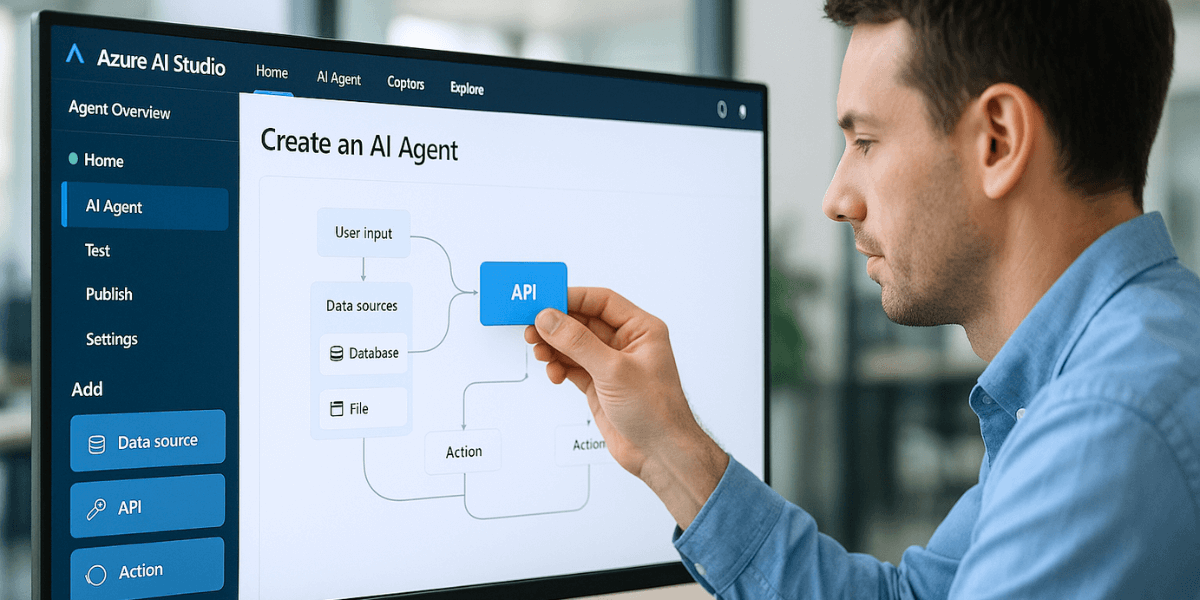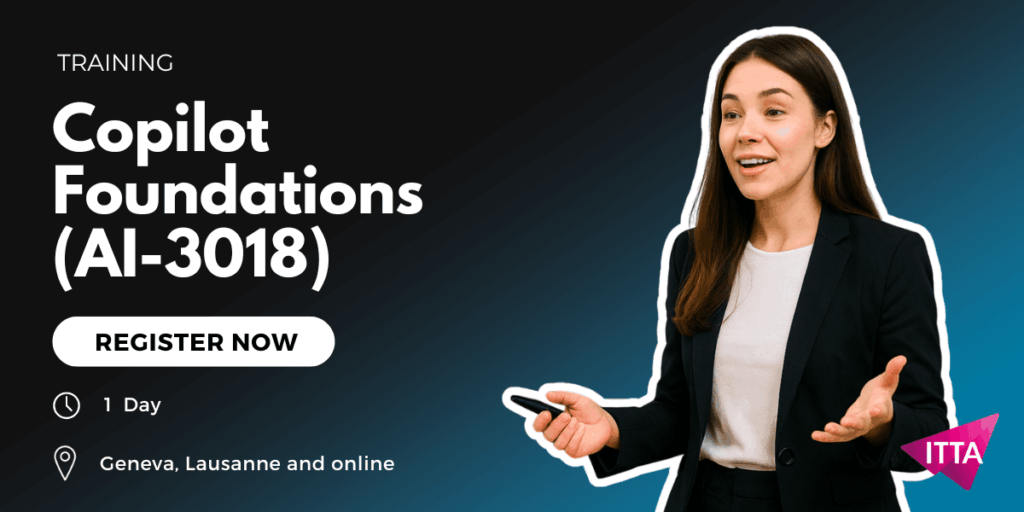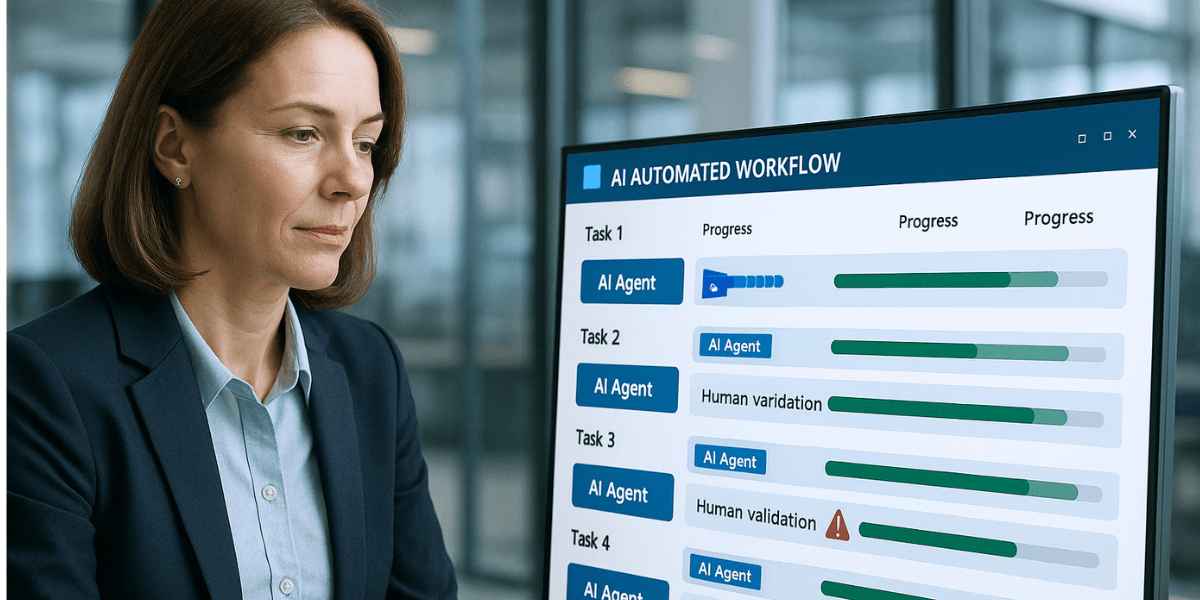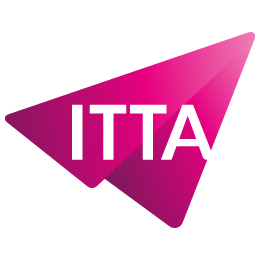Home > Microsoft Bets on Agentic AI: A Pragmatic and Secure Strategy
For several years, Microsoft has been heavily investing in artificial intelligence, with a clear ambition: to make AI a driver of efficiency, innovation, and transformation for businesses. But beyond generic discussions about generative AI, the American company is now presenting a more advanced and targeted vision: that of agentic artificial intelligence.
Behind this technical term lies an evolution of AI toward systems that are not only able to understand human language, but also to take action in specific contexts, through business tools. Copilot, GitHub, Azure, Microsoft 365… the entire Microsoft ecosystem is now designed to integrate these intelligent, semi-autonomous, and always supervised agents.
This article explores Microsoft’s agentic AI strategy: its core principles, real-world applications, technological implications, and the ethical, sovereignty, and data governance challenges it raises.

Agentic artificial intelligence refers to AI capable not only of understanding natural language instructions, but above all, of performing actions in a targeted and structured way. Unlike purely conversational models, an AI agent is designed to act within a defined environment, using tools, APIs, or databases.
For Microsoft, an AI agent is not just a chatbot or voice assistant. It is an intelligent system capable of analyzing a situation, making decisions within a defined scope, and above all executing concrete actions in a given environment.
An agent consists of three fundamental building blocks:
The agent can, for instance, trigger automations, extract data from unstructured documents, or interact with ERP or CRM systems. It acts, but never decides outside of its scope: human oversight and technical safeguards are always in place.
Microsoft deliberately avoids the term “autonomous agent.” According to Donna Sarkar, Chief Technology Officer for copilots at Microsoft, “There aren’t really many truly autonomous agents in the world, and I don’t think there should be right now.” (source: ictjournal.ch) The company advocates a pragmatic approach: semi-autonomous agents, capable of acting quickly, but always under control.
This positioning contrasts with some futuristic visions of omnipotent AI. Microsoft remains grounded in productivity, business performance, and responsibility.

The deployment of copilots in Word, Excel, Outlook, or Teams embodies this agentic vision. The copilot is not just a simple query interface, but an assistant that knows where to find information, how to rephrase it, structure it, and even trigger actions in context.
Example: in Excel, the copilot can extract data, cross it with external data via an API, generate visualizations, and then automatically send a report in Teams. It’s a chain of logical actions, guided by the user but executed by the agent.
In the development field, GitHub Copilot and Azure DevOps also embed intelligent agents. They can generate code, detect bugs, suggest fixes, and even orchestrate CI/CD workflows. Combined with AI agents, these tools become true development assistants, capable of automating repetitive tasks and improving quality.
Microsoft also focuses on ease of creation. With Copilot Studio or Azure AI Studio, it becomes possible to configure an agent in just a few minutes by connecting data sources, specific instructions, and business tools. This “no-code / low-code” approach enables business teams to create their own agents without always relying on the IT department.

Most of Microsoft’s AI agents rely on techniques such as RAG (Retrieval-Augmented Generation). This approach combines a language model with business data stored locally or in the cloud. The result: the agent delivers more accurate responses, based on the company’s specific information.
Tool orchestration (plugins, APIs, connectors) is also at the core of the system. The agent acts as an interface between the user, IT systems, and artificial intelligence. It can “chain” complex actions based on a well-defined prompt.
Microsoft emphasizes the need for a trusted framework: access control, data encryption, log management, and ethics by design. Each agent is part of a strict governance structure regarding permissions and human oversight.
Microsoft’s “Responsible AI” approach is reflected in transparent documentation, model audits, and monitoring tools for IT administrators. This is crucial for sensitive industries such as healthcare, finance, and public administration.

By 2027, Microsoft aims to make agentic artificial intelligence a natural and integrated part of the daily lives of businesses, governments, and citizens. The goal is threefold: to accelerate productivity, strengthen local digital sovereignty, and ensure ethical and secure AI deployment across all sectors.
In practical terms, Microsoft aims for as many organizations as possible to have personalized intelligent agents. These agents are capable of interacting with their information systems, automating complex tasks, and supporting decision-making. They won’t be reserved for large tech companies: thanks to no-code/low-code tools like Copilot Studio, they will be accessible to SMEs, public administrations, schools, and hospitals.
In Switzerland, this goal translates into the rise of local infrastructure (datacenters compliant with legal requirements), stronger partnerships with Swiss education and tech players, and training thousands of professionals in AI skills. Microsoft thus aims to actively contribute to the country’s digital autonomy, while respecting Swiss and European ethical standards.
With its vision of agentic artificial intelligence, Microsoft reinforces its position as a tech leader, but also as a pragmatic and responsible actor. For the company, AI is not an end in itself. It’s a lever. A tool. A copilot designed to enhance human capabilities, accelerate processes, and ensure full control over data and usage.
This approach resonates strongly in a world where security, ethics, and sovereignty are increasingly important. Microsoft addresses this with a structured vision: intelligent agents that are supervised, interoperable, and responsible. A real-world AI, built for today’s challenges.
Source: www.ictjournal.ch

What is agentic artificial intelligence according to Microsoft?
According to Microsoft, agentic artificial intelligence is AI designed to act within a defined framework. It doesn’t just understand natural language it performs targeted actions through tools, APIs, and business systems. It is built on three core components: a language model (e.g., GPT-4), a structured prompt, and connectors. The goal: boost productivity while maintaining consistent human oversight.
What is the difference between an AI agent and a simple chatbot?
A chatbot answers questions, often in a linear fashion. An AI agent, on the other hand, acts within a business environment. It can extract data, generate a report, interact with a CRM, or orchestrate an entire workflow. It is much more than a conversational assistant: it is an intelligent executor, designed to automate tasks in specific contexts.
Is Microsoft developing truly autonomous AI agents?
No. Microsoft favors an “autonomous-ish” approach: agents are semi-autonomous, capable of acting independently but always supervised by human and technical safeguards. This position contrasts with the vision of fully autonomous AI, which Microsoft considers premature and risky. The focus is on responsibility, oversight, and security.
Which Microsoft tools already include AI agents?
Several key products in the Microsoft ecosystem already feature intelligent agents:
What is Microsoft’s vision for agentic AI by 2027?
By 2027, Microsoft aims to make agentic AI a secure, integrated, and widely accessible technology. The goal: enable organizations, including SMEs and public institutions, to deploy customized AI agents to automate their tasks. This vision also includes a strong commitment to digital sovereignty, particularly in Switzerland.

ITTA is the leader in IT training and project management solutions and services in French-speaking Switzerland.
Our latest posts
Subscribe to the Newsletter

Nous utilisons des cookies afin de vous garantir une expérience de navigation fluide, agréable et entièrement sécurisée sur notre site. Ces cookies nous permettent d’analyser et d’améliorer nos services en continu, afin de mieux répondre à vos attentes.
Monday to Friday
8:30 AM to 6:00 PM
Tel. 058 307 73 00
ITTA
Route des jeunes 35
1227 Carouge, Suisse
Monday to Friday, from 8:30 am to 06:00 pm.